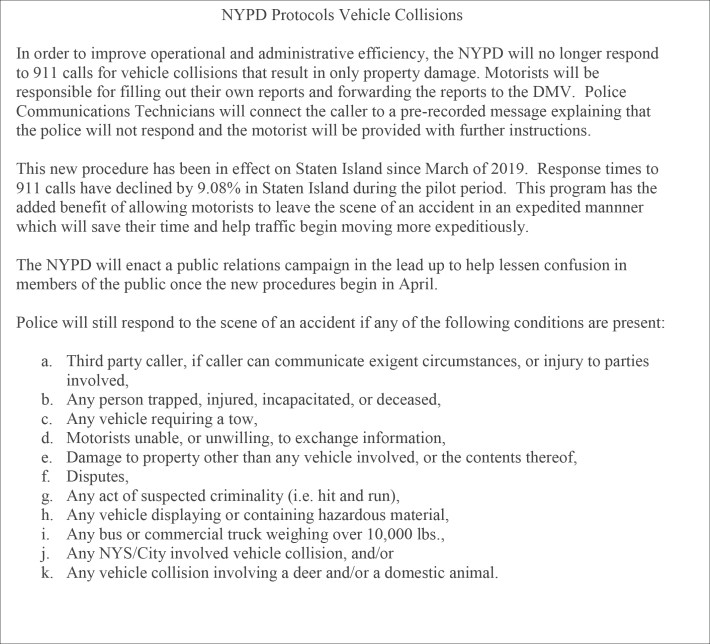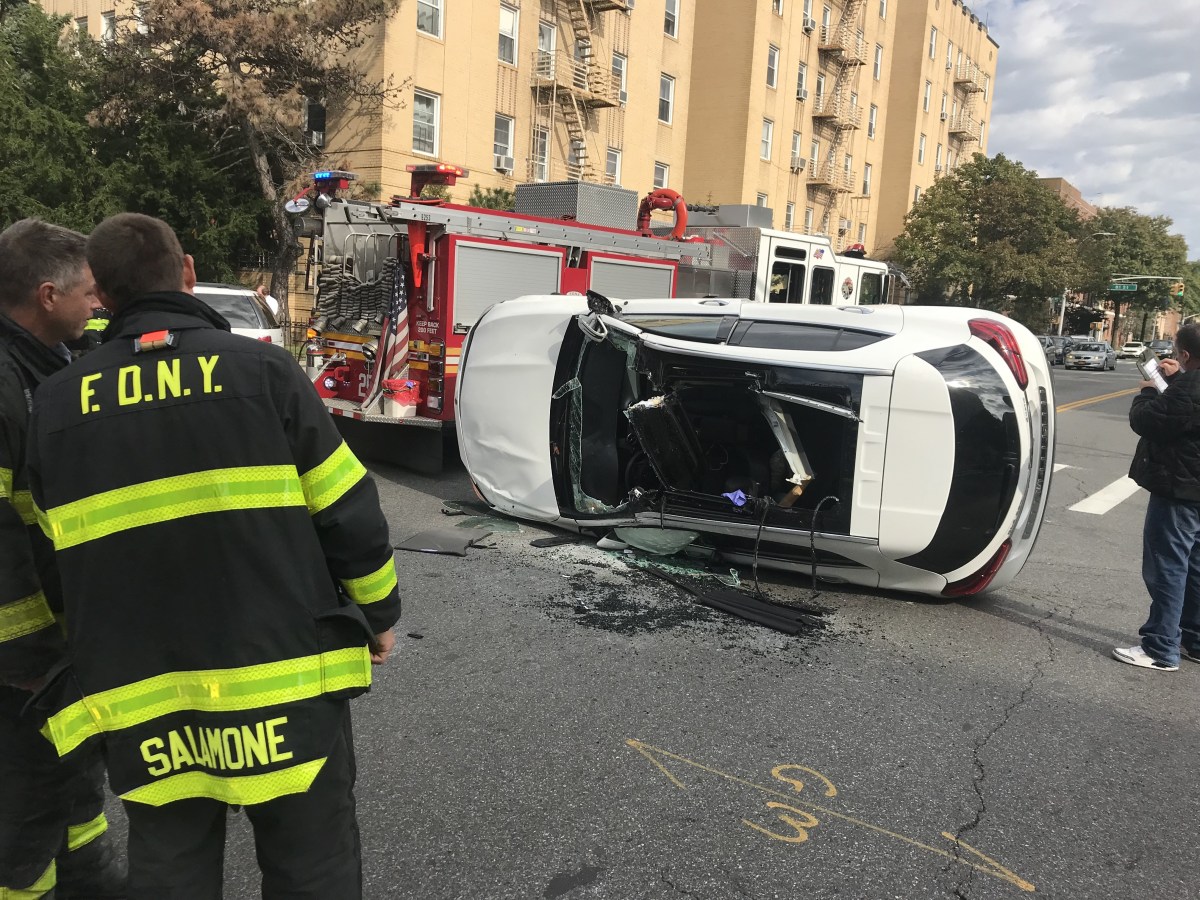The NYPD says its plan to stop sending cops to the scene of minor car crashes will free up officers for more important work and reduce congestion — all "without sacrificing safety," the agency claims.
On Friday, the NYPD finally issued some limited information about its plan — first reported earlier this week by Streetsblog — to no longer respond when an automobile crash results only in property damage or minor damage to the vehicles involved. It's a controversial policy that started as a pilot program last year in Staten Island and has resulted in far fewer crashes being reported, meaning that city statistics now appear to show many roadways as safer than they may actually be.
On the plus side, the NYPD says that emergency response times on Staten Island improved during the pilot, which began last March. It is unclear why.
In a statement, the agency alluded to the COVID-19 crisis as a reason to expand the program citywide, but also admitted that the program was going to be expanded anyway. (In fact, one could argue that the crisis is the worst time to roll out a new policy, given that drivers are driving so recklessly because so few cars are on the road right now, as Streetsblog reported.)
As such, Transportation Alternatives Deputy Director Marco Connor DiAquoi had serious questions about the timing of the policy change and the lack of details provided. He issued the following statement:
Obviously, under normal circumstances this would be an unacceptable policy for several reasons. However, these are not normal times. The NYPD's personnel challenges are real, with precincts stretched beyond capacity due to the coronavirus.
That said, this is yet another reason why we need bold and sensible leadership from our Mayor. Just as there is a dire need to "lower the baseline" of injury crashes in order to alleviate the strain on hospitals and first responders, our city must urgently do the same overall for non-injury traffic crashes overall. Mayor de Blasio must close down car lanes and streets to open up safe space for walking and biking, and must prohibit all non-essential driving. For this new NYPD policy to be responsible, it must be accompanied immediately by these and other measures to reduce car-trips,.
And as soon as possible, the city must establish mechanism for these crashes to be reported in lieu of the police officer response.
The NYPD declined to make Commissioner Dermot Shea or Transportation Bureau Chief William Morris available for interviews, and would not answer follow-up questions. We had several:
- If NYPD officers no longer show up to minor crashes, doesn't that mean that many drivers will avoid traffic citations to which they would have been subject pending a police review of the crash? In other words, just because a crash is minor, it doesn't mean a driver was not to blame for failing to yield or using a cellphone will driving. What will happen to those tickets?
- Same question for a car-on-cyclist crash: If a car driver fails to yield to a cyclist or pedestrian — one of the most-common vehicular crimes in New York City — but the biker or walker is not injured, it will up to the vulnerable road user (the cyclist or pedestrian) to "make an issue" of the incident, which would still require cops to show up. Would those responding officers — who have grown unaccustomed to responding to minor crashes — be sensitive to the vulnerable road user's concern?
- There were 165,707 non-injury-causing crashes in New York City last year, roughly 454 per day. If the same pattern from Staten Island holds for the entire city, that number will not drop, but NYPD statistics will give the impression that the number of crashes has dropped to roughly 62,000, or 169 per day. Will city officials suddenly start to see crashes as not as crucial an issue because NYPD reports on more than 100,000 crashes have simply disappeared?
- How will officials know if crashes result in insurance fraud, given that no honest broker, such as a law-enforcement authority, will be involved in reporting the crash?

A previously leaked memo did answer some of Streetsblog's other questions. For instance, cops will still be required to show up if:
- one of the parties involved in the crash disputes the other person's side of the story.
- someone is injured.
- the report is phoned in by a third party (perhaps a witness who was not involved).
- one of the people involved in the crash has fled.
- either vehicle is damaged so badly that it needs to be towed.
- a deer or a domesticated animal is struck (no, seriously).
Lawyer Steve Vaccaro, who has previously supported the new policy on the grounds that it will remove police from the role of insurance claims adjusters — and save taxpayers money — did agree that the no-response policy is ripe for "abuse."
"Cops will try to get victims at the scene to minimize their injuries, or will simply attribute to them the false statement that they are not injured, as a way of avoiding having to do the work of making a report," said Vaccaro, who is a Streetsblog advertiser. "But cops are already doing those things anyway. I had a 7-year-old run over by a pickup truck (operated by an off-duty copy) and the cop responding to write the 'accident report' described the kid as having 'minor injuries.' In fact, the kid will live the rest of her life with one leg shorter than another and a host of other problems."
But Vaccaro believes such abuse will be rare.
"At the end of the day, the vast majority of motor vehicular-related police calls are for property damage only," he said. "Unless we can get police out of the motor vehicle/public safety business entirely, we need to focus them on motor vehicle calls that present a clear and compelling claim to being incidents of traffic violence. That is the only way we can educate the cops, over time, to take motor vehicle calls seriously. I understand that reasonable minds can differ."
Speaking of differing, here is the NYPD's full, unedited press release (which we are publishing because, frankly, it's so rare to get a press release from the NYPD):
The NYPD is expanding the Non-Injury Collision Pilot citywide, beginning Monday April 6, to save time for NYPD patrol officers as well as New Yorkers without sacrificing safety. This means that vehicle collisions resulting only in property damage are not required to be reported to the police.
"These are unprecedented times and this citywide expansion will enable officers to respond to critical safety related calls faster, while also saving New Yorkers time," said NYPD Police Commissioner Dermot Shea. "In life or death situations, a matter of seconds can make all the difference. This expansion is also contact limiting which will help to keep the men and women of the NYPD -- and the New Yorkers they serve -- safe."
It is important New Yorkers know that if they feel unsafe for any reason, if there are injuries, or if the owner of one of the vehicles cannot be located, individuals should call 911 immediately and officers will respond.
The NYPD piloted this initiative starting in March of 2019 on Staten Island, and conducted an evaluation from March 18, 2019 through Sept. 15, 2019. Following its success, the Department has been planning to expand the program citywide. In light of the coronavirus pandemic and the new challenges the NYPD faces, the Department determined now is the right time to expand for several reasons. From March 12 when the State of Emergency was first declared in New York City, New Yorkers have dramatically limited their driving. However, from March 12 to 29, there have been 4,708 non-injury vehicle collisions where NYPD has been called to the scene. In addition, this expansion assists with limiting contact and exposure between officers and New Yorkers and enables officers to continue to provide critical safety related services faster.
The pilot evaluation found that response times in Staten Island decreased 9 percent for all 911 calls, which means people in serious danger received help faster. In addition, 61 percent of 911 calls were deferred, saving an average of 45 minutes of wait time for New Yorkers. This also reduced traffic, as individuals did not have to wait on the road with their vehicles for police. As part of the pilot evaluation, the Department conducted a survey with Staten Island residents to evaluate the efficacy of the program, and from the results, clarified the automated message to ensure New Yorkers had clear instructions and next steps in advance of this expansion.
The NYPD consulted with other police departments such as the Los Angeles Police Department, which has utilized a non-injury collision policy since 1998.
Additional information about collisions:
- Drivers are responsible for exchanging driver's license information, insurance, and vehicle registration with all other motorists involved and filing a Report of Motor Vehicle Accident (MV104) with DMV if property damage is more than $1000 to any one of the vehicles involved.
- 911 call takers that continue to receive calls about property-only vehicle collisions will divert callers to an automated message that will explain the new policy and explain how to exchange information.
- Leaving the scene of a collision before exchanging your information with other motorists is illegal under the New York State Vehicle and Traffic Law. Furthermore, drivers are required to remain on the scene and contact the police immediately after a vehicle collision when: Any person is injured or killed; a domestic animal is injured or killed; or, a parked vehicle, or any other property is damaged, and the owner cannot be located.
- For insurance purposes, a Report of Motor Vehicle Accident should be filed with the Department of Motor Vehicles. This form can be found online at dmv.ny.gov/forms/mv104.pdf, or at your local precinct or police service area.
For more information, go to nyc.gov/collision.






